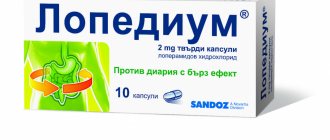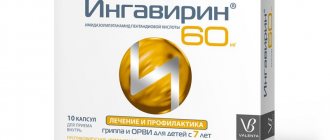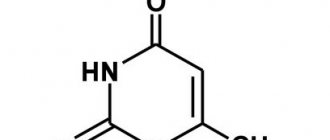Drops are a popular form of medication in ophthalmology. The products differ in composition and, accordingly, in purpose.
Vitabact are drops with antimicrobial and antiseptic effects. The drug is in demand in ophthalmology for the treatment of various infectious diseases and the prevention of infections in the field of surgical interventions.
Pharmacodynamics and pharmacokinetics
When using this drug, an antimicrobial effect is manifested. The main component of the solution, picloxidine, biguanide derivative .
Eye drops are active against Streptococcus faecalis, Staphylococcus aureus, Eberthella typhosa, Escherichia coli, Klebsiella pneumoniae, Proteus vulgaris, Shigella dysenteriae, Bacillus subtilis, some fungi, viruses and other microorganisms.
With topical use of the drug, low systemic absorption of picloxidine was noted.
Features of drops
- Vitabact eye drops are an effective remedy with antimicrobial properties. The solution is transparent. A slight yellowish tint to the droplets is allowed. The product is packaged in convenient 10 ml glass bottles equipped with a convenient dropper. The active substance in the drug is picloxidine dihydrochloride. Additionally, auxiliary components are used to ensure the integrity of the droplet structure. These are purified water, polysorbate and dextrose.
- Vitabact eye drops, the instructions warn about this, are intended exclusively for instillation. Subconjunctival administration of the drug is prohibited.
- After instillation, there may be a deterioration in vision clarity. Therefore, it is not recommended to drive after the procedure. You should also avoid performing operations with complex mechanisms.
- You can buy Vitabact eye drops without a prescription. The period of use of the drug after opening the drug is no more than a month.
Vitabact eye drops, instructions for use (Method and dosage)
As the instructions for Vitabact indicate, instillation should be done 2-6 times a day, 1 drop. The duration of therapy is 10 days. An increase in the therapeutic course is allowed only on the recommendation of a doctor.
To prevent infection, a daily dose of 1 drop of the drug is prescribed 3-4 times. When carrying out preoperative preparation - 2 drops before the intervention.
To open the bottle, you need to screw the cap all the way. Instillation of the solution is performed with the head thrown back and the gaze directed upward, into the lower conjunctival sac. It is important to prevent the dropper from touching your eyes, eyelids, and fingers.
Indications for use
Eye drops are prescribed in the presence of pathological conditions:
- conjunctivitis;
- damage by bacterial microflora of the anterior part of the eyes;
- keratitis;
- preventive measure against infection with viral conjunctivitis;
- blepharitis;
- infectious lesions due to obstruction of the lacrimal canal;
- dacryocystitis;
- prevention of complications after surgery;
- iritis;
- to prevent the development of complications due to cleaning the lacrimal canal;
- elimination of inflammation due to trachoma.
Analogs
Level 4 ATX code matches: Dancil
Oftadek
Signitsef
Oftaquix
Okomistin
Tsiprolet
Analogues of Vitabact are represented by the following drugs: Tobradex, Quinax, Okomistin and Korneregel.
Shelf life and storage
After the date of manufacture, the medicine is suitable for use for 2 years. After the first opening, the shelf life is reduced to 30 days. After this period, the product should be disposed of. Do not allow children to use the product independently.
Vitabact eliminates not only the pathology itself, but also acts as a preventive measure against infection. The medicine has a minimum of side effects, which indicates its safe use by children. Before first use, it is advisable to check for allergies to the components of the medication.
Author's rating
Author of the article
Alexandrova O.M.
Articles written
2100
about the author
Was the article helpful?
Rate the material on a five-point scale!
( 4 ratings, average: 3.00 out of 5)
If you have any questions or want to share your opinion or experience, write a comment below.
Reviews about Vitabact
It is known that this drug is often used to treat young patients. Vitabact is prescribed for newborns when it is necessary to normalize the patency of the tear ducts. Eye drops for newborns help to effectively clean the eyes and prevent the development of inflammatory processes.
As reviews of Vitabact eye drops show, in most cases their use is quite effective. But, unfortunately, the drug does not always help, so patients are forced to use radical measures.
According to experts, the effectiveness of this drug largely depends on the structural features of the lacrimal canal and the causative agent of the infection. If the patient has a narrow tear duct, then the use of antimicrobial agents will not bring the desired effect.
Contraindications and side effects
An absolute contraindication for Vitabact eye drops is individual intolerance to the components in the medication. Studies on the effects on the fetus and newborn child during pregnancy and lactation have not been conducted. Therefore, it is not recommended for use in treating women while pregnant and breastfeeding.
No adverse reactions have been recorded when using eye drops. Only if there is intolerance to the components there is a risk of developing allergic reactions. As a rule, they are manifested by swelling and redness of the conjunctiva. Overdose of the drug has not been confirmed in practice.
Experience in the use of combination drugs in the treatment of rhinitis and sinusitis in children
The incidence of sinusitis is still quite high. According to various authors, diseases of the nose and paranasal sinuses affect from 17 to 22% of the child population. One of the significant factors in the pathogenesis of acute and especially chronic inflammatory diseases of the nose and paranasal sinuses is a violation of the mechanism of mucociliary transport. This is most often associated with swelling of the mucous membrane, excessive formation and increased viscosity of nasal secretions, which entails a disorder of drainage, respiratory, secretory and olfactory functions. The most common treatment for sinusitis is oral or intramuscular antibiotics. Since the supply of antibiotics from the bloodstream to the site of inflammation is limited, the treatment of sinusitis must be comprehensive.
First of all, this should concern improving ventilation, as well as drainage of the paranasal sinuses and nasopharynx.
Until now, otolaryngologists do not always practice prescribing adequate mucoregulating drugs included in the treatment regimen for patients with sinusitis, which, by thinning the thick viscous secretion and improving mucociliary clearance, help remove secretions from the sinuses. Among the drugs that affect mucociliary activity, previously used drugs that stimulate the liquefaction of rhinobronchial secretions, or so-called mucolytics, which change the viscosity of the secretion, affecting its physicochemical properties. We are talking about enzymes (trypsin, chymotrypsin, etc.), which are not currently used due to side effects.
Drugs that reduce surface tension also have a mucolytic effect, i.e., they act on the gel phase of the discharge and dilute both sputum and nasopharyngeal secretions. This group includes fluimucil (N-acetylcysteine), the action of which is associated with the ability of the free sulfhydryl group of N-acetylcysteine to cleave the intermolecular disulfide bonds of mucus glycoprotein aggregates, exerting a strong liquefying effect and reducing viscosity in relation to any type of secretion: purulent, mucopurulent, mucous . The peculiarity of fluimucil is that in addition to the direct mucolytic effect, N-acetylcysteine has powerful antioxidant properties and is able to protect the respiratory system from the cytotoxic effects of inflammatory metabolites, environmental factors, and tobacco smoke.
In the group of mucolytics, combination drugs are of great interest, namely rhinofluimucil, which, in addition to N-acetylcysteine, which dilutes the secretions, includes a sympathomimetic - tuaminoheptane sulfate, which has a mild vasoconstrictor effect and does not cause excessive dryness of the mucous membrane. After the disulfide bridges break, mucus and phlegm lose their viscosity, begin to absorb water and are gently removed when blowing the nose, sneezing, or coughing. Indications for the use of rinofluimucil are:
- prolonged purulent sinusitis with viscous thick secretion;
- chronic rhinitis with the formation of crusts in the nasal cavity and nasopharynx;
- vasomotor rhinitis with thick viscous discharge.
The effectiveness of the drug was assessed in a group of 55 patients aged 6 to 14 years; rinofluimucil was injected one dose into each half of the nose 3-4 times a day, the course was 6-7 days. The condition of the children was assessed by their subjective feelings before and after using the drug, as well as by objective criteria (reduction of hyperemia and congestion in the mucous membrane, improvement of nasal breathing, reduction of mucus, change in its rheological properties).
After 6-8 inhalations of rhinofluimucil, positive dynamics were noted.
The result of using the drug was assessed as follows: 70% of patients - excellent; 20% - good; 10% - satisfactory.
| Drawing. Comparative results of treatment with the antibiotic fluimucil IT and traditional methods |
There were no side effects from the use of the drug. The advantage of rhinofluimucil is that it acts on the surface of the mucous membrane and, by thinning the mucus, reduces its viscosity and promotes the productive physiological act of cleansing the nasal cavity.
The next drug that you should pay attention to is the fluimucil antibiotic IT, which combines two components in one dosage form: N-acetylcysteine and thiamphenicol glycinate (thiamphenicol is a drug from the chloramphenicol group). The spectrum of antimicrobial activity of the drug is presented in table. 1 (Clinical pharmacology of antibacterial drugs/Ed. Yu. B. Belousov, 1988).
The drug has a combined antibacterial and mucolytic effect and is recommended for the treatment of respiratory diseases caused by bacterial infection and accompanied by the formation of a thick viscous secretion. The antimicrobial activity of thiamphenicol is due to its interference with the synthesis of bacterial proteins. Recent studies have shown that the combination of thiamphenicol and N-acetylcysteine allows the drug to retain its unconjugated form and reach the site of inflammation in concentrations sufficient to create a bactericidal effect. The drug exhibits mucolytic activity against any type of secretion - mucous, mucopurulent, purulent. Fluimucil antibiotic IT facilitates the separation of sputum and nasal mucus. The drug is effective when administered into the paranasal sinuses.
We have data on treatment with the drug fluimucil-antibiotic IT in 37 children, of which 17 were diagnosed with acute sinusitis, 10 with exacerbation of chronic sinusitis and 10 with exacerbation of chronic purulent sinusitis. The control group of patients was treated using the traditional method without the use of fluimucil antibiotic. Comparative data is presented in the figure.
The drug was used for washing the paranasal sinuses after punctures or after surgery, including after endonasal opening of the ethmoidal labyrinth cells. Good results were obtained after 2-3 rinses: nasal breathing improved, swelling of the nasal mucosa decreased, the amount of secretion decreased, and its purulent nature disappeared. Indications and methods of use of the drug are presented in table. 2.
The effectiveness of the IT antibiotic fluimucil is determined not only by its antibacterial effect, but also by its ability to ensure rapid and complete removal of exudate, which in turn enhances the antibacterial effect.
Literature
- Ammosova S.P., Chuchalin A.G. et al. The effectiveness of N-acetylcysteine therapy in the treatment of liquidators of the Chernobyl accident with chronic bronchitis.
- Balyasinskaya G. L., Minasyan V. S., Kachkaeva E. D. The use of rinofluimucil in the treatment of rhinitis in children: Collection of works of the department. M., 2001. pp. 162-165.
- Garashchenko T. I., Bogomilsky M. R., Radtsig E. Yu. Mucoactive drugs in the treatment of non-purulent diseases of the middle ear: Collection of works of the department. M., 2001. pp. 157-162.
- Levin A. R., Zaitseva O. V., Vykhristyuk O. F., Kasyanov E. N. Results of the use of acetylcysteine in the complex treatment of children with bronchopulmonary diseases // Pediatrics. 1995. No. 5. P. 66-68.
- Sinopalnikov A.I., Klyachkina I.L. The place of mucolytic drugs in the complex therapy of respiratory diseases // Russian Medical Bulletin. No. 4. pp. 9-10.
- Samsygina G. A. et al. Experience in the use of acetylcysteine in the treatment of acute and chronic respiratory diseases in children // Pediatrics. 1995. No. 3. P. 76.
- Rizzata J. Aerosol antibiotics for the treatment of respiratory infections. The focus is on thiamphenicol glycinate acetylcysteinate. Publishing house "Mattioli", 1985, Therapist, 2001. No. 9. P. 1-6.
Note!
Fluimucil antibiotic IT has the following pharmacological and therapeutic properties:
- High bioavailability of the drug.
- High antibacterial activity, which is achieved thanks to a special dosage form.
- High mucolytic activity, ensuring the restoration of mucociliary clearance and the removal of pathological microorganisms.
- By creating a high therapeutic concentration of both an antibiotic and N-acetylcysteine in the affected organs.
pharmachologic effect
The antimicrobial effect of the drug is due to the activity of picloxidine dihydrochloride against:
- Staphylococcus aureus;
- chlamydia;
- shigella;
- Klebsiella;
- streptococci;
- coli;
- mushrooms;
- some viral microorganisms;
- causative agent of typhoid fever.
Being a biguanide derivative, Vitabact has an antiseptic, anti-inflammatory, and antimicrobial effect.
Note! When used locally, the drops do not penetrate the bloodstream and do not affect systemic processes, and therefore are allowed for use in children from birth.







